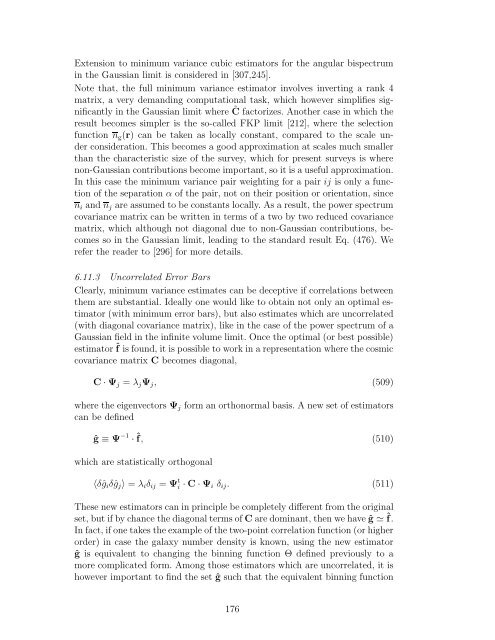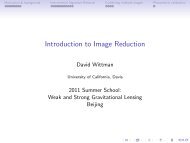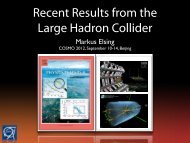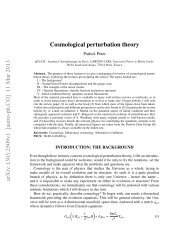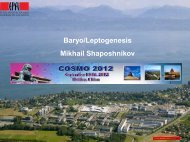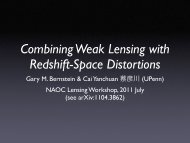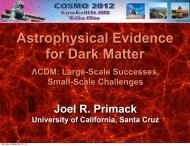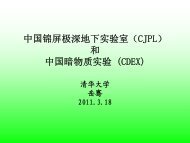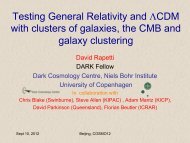Large-Scale Structure of the Universe and Cosmological ...
Large-Scale Structure of the Universe and Cosmological ...
Large-Scale Structure of the Universe and Cosmological ...
You also want an ePaper? Increase the reach of your titles
YUMPU automatically turns print PDFs into web optimized ePapers that Google loves.
Extension to minimum variance cubic estimators for <strong>the</strong> angular bispectrum<br />
in <strong>the</strong> Gaussian limit is considered in [307,245].<br />
Note that, <strong>the</strong> full minimum variance estimator involves inverting a rank 4<br />
matrix, a very dem<strong>and</strong>ing computational task, which however simplifies significantly<br />
in <strong>the</strong> Gaussian limit where ˜ C factorizes. Ano<strong>the</strong>r case in which <strong>the</strong><br />
result becomes simpler is <strong>the</strong> so-called FKP limit [212], where <strong>the</strong> selection<br />
function ng(r) can be taken as locally constant, compared to <strong>the</strong> scale under<br />
consideration. This becomes a good approximation at scales much smaller<br />
than <strong>the</strong> characteristic size <strong>of</strong> <strong>the</strong> survey, which for present surveys is where<br />
non-Gaussian contributions become important, so it is a useful approximation.<br />
In this case <strong>the</strong> minimum variance pair weighting for a pair ij is only a function<br />
<strong>of</strong> <strong>the</strong> separation α <strong>of</strong> <strong>the</strong> pair, not on <strong>the</strong>ir position or orientation, since<br />
ni <strong>and</strong> nj are assumed to be constants locally. As a result, <strong>the</strong> power spectrum<br />
covariance matrix can be written in terms <strong>of</strong> a two by two reduced covariance<br />
matrix, which although not diagonal due to non-Gaussian contributions, becomes<br />
so in <strong>the</strong> Gaussian limit, leading to <strong>the</strong> st<strong>and</strong>ard result Eq. (476). We<br />
refer <strong>the</strong> reader to [296] for more details.<br />
6.11.3 Uncorrelated Error Bars<br />
Clearly, minimum variance estimates can be deceptive if correlations between<br />
<strong>the</strong>m are substantial. Ideally one would like to obtain not only an optimal estimator<br />
(with minimum error bars), but also estimates which are uncorrelated<br />
(with diagonal covariance matrix), like in <strong>the</strong> case <strong>of</strong> <strong>the</strong> power spectrum <strong>of</strong> a<br />
Gaussian field in <strong>the</strong> infinite volume limit. Once <strong>the</strong> optimal (or best possible)<br />
estimator ˆ f is found, it is possible to work in a representation where <strong>the</strong> cosmic<br />
covariance matrix C becomes diagonal,<br />
C · Ψj = λjΨj, (509)<br />
where <strong>the</strong> eigenvectors Ψj form an orthonormal basis. A new set <strong>of</strong> estimators<br />
can be defined<br />
ˆg ≡ Ψ −1 · ˆ f, (510)<br />
which are statistically orthogonal<br />
〈δˆgiδˆgj〉 = λiδij = Ψ t i · C · Ψi δij. (511)<br />
These new estimators can in principle be completely different from <strong>the</strong> original<br />
set, but if by chance <strong>the</strong> diagonal terms <strong>of</strong> C are dominant, <strong>the</strong>n we have ˆg ≃ ˆ f.<br />
In fact, if one takes <strong>the</strong> example <strong>of</strong> <strong>the</strong> two-point correlation function (or higher<br />
order) in case <strong>the</strong> galaxy number density is known, using <strong>the</strong> new estimator<br />
ˆg is equivalent to changing <strong>the</strong> binning function Θ defined previously to a<br />
more complicated form. Among those estimators which are uncorrelated, it is<br />
however important to find <strong>the</strong> set ˆg such that <strong>the</strong> equivalent binning function<br />
176


